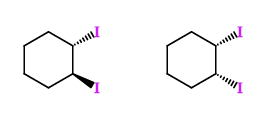
The two molecules above can best be described as:
A) Structural isomers
B) Diastereomers
C) Enantiomers
D) Conformational isomers
Explanation
A) Structural isomers
B) Diastereomers
C) Enantiomers
D) Conformational isomers
The molecule on the left is trans 1, 2-diiodocyclohexane. The molecule on the right is cis 1, 2-diiodocyclohexane. Cis and trans molecules are a type of diastereomer called geometric isomers.
A: Structural isomers have fundamentally different connectivity between the atoms. So for example if the iodine were on carbons 1 and 3 and then in the other molecule on carbons 1 and 4, that would be structural isomers.
C: Enantiomers are mirror image reflections of each other, which these molecules are not.
D: Conformations isomers allow you to freely interconvert between the molecules without breaking any bonds. The classic example is chair and boat cyclohexane. Here, to flip the one iodine from R to S configuration would require breaking a bond in the ring, rotating, and then re-attaching. That requirement for bond-breaking means these are not conformers.
Want more MCAT practice?
We’ve got options for every schedule and learning style!
From the best online MCAT course created by top instructors with 524+ MCAT scores to the most representative full-length practice exams and private tutoring, we can custom tailor your MCAT prep to your goals!
Not sure which option is right for you? Schedule a free MCAT consultation with an MCAT Advisor using the form below. No obligation, just expert advice.
Search the Blog

Free Consultation
Interested in our Online MCAT Course, One-on-One MCAT Tutoring or Med admissions packages? Set up a free consultation with one of our experienced Senior Student Advisors.
Schedule NowPopular Posts
-
MCAT Blog What's on the MCAT?
-
MCAT Blog How to Review MCAT Full Lengths

Free MCAT Practice Account
Need great MCAT practice?Get the most representative MCAT practice possible when you sign up for our free MCAT Account, which includes a half-length diagnostic exam and one of our full-length MCAT practice exams.
Learn More







